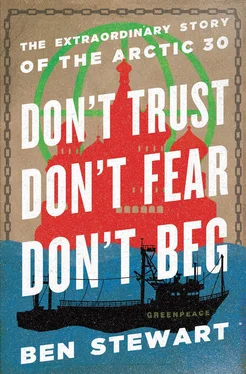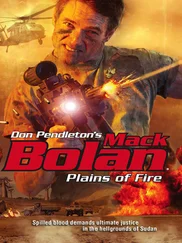Greenpeace had already been campaigning in the Arctic for fifteen years. Activists had confronted BP’s Northstar drilling operations in Alaska; Greenpeace ships had documented climate change impacts off Greenland and Svalbard; and Mads Christensen’s team in Scandinavia had campaigned against the industrial fishing fleets taking their destructive methods to the Arctic.
But it was Deepwater Horizon that provided the spark for a new wave of action. With the world’s oil giants moving into the melting waters above the Arctic Circle, Sauven got his way and the Greenpeace ship Esperanza sailed north to confront the new Arctic oil rush.
That summer Greenpeace played a cat-and-mouse game with the Danish navy – still the governing power in Greenland. The activists outpaced the Danish special forces RHIBs and occupied the underside of the Cairn platform, forcing a temporary shutdown.
The following year Greenpeace returned to Greenland, this time with Frank Hewetson leading the logistics operation. He hung a pod and two occupants from another Cairn oil platform, halting exploratory drilling operations for two days. After the Danish navy removed the pod, Frank led a team of eighteen activists who scaled the platform and presented a petition to the captain containing fifty thousand names calling for an end to Arctic oil drilling. Frank and the others were arrested and helicoptered to Greenland, where they were jailed for two weeks.
WikiLeaks had just published a quarter of a million cables from US embassies across the world. They showed how the scramble for resources in the Arctic was sparking military tensions in the region – with NATO sources worried about the potential for armed conflict between Russia and the West. The cables showed the extent to which Russia was manoeuvring to claim ownership over huge swathes of the Arctic. One senior Moscow source revealed that a famous 2007 submarine expedition by the explorer Artur Chilingarov to plant a Russian flag on the seabed beneath the North Pole was ordered by Vladimir Putin’s United Russia party.
Another cable detailed the lengths to which the USA was going to carve out a strong position in Greenland, and the concerns Washington had over Chinese manoeuvring on the island. Tensions within NATO were also exposed, as Canadian leaders privately expressed disquiet in the cables over the Western alliance’s mooted plans to project military force in the Arctic in the face of perceived Russian aggression. Canadian Prime Minister Stephen Harper was quoted by diplomats as saying that a NATO presence in the region would give non-Arctic members of the alliance too much influence in an area where ‘they don’t belong’. [46] http://news.bbc.co.uk/1/hi/programmes/newsnight/9483790.stm
For an earlier generation the Arctic was the stage for Armageddon. Across the vast silence of the frozen north, two superpowers had ranged their armadas of nuclear warheads against each other’s cities. The skies above the pole were the shortest and quickest route to bring about the end of human life on Earth. And now, for a new generation, the Arctic was again the stage on which their future would be decided. A military build-up was under way as the oil giants prepared to colonise one of the last unclaimed corners of the Earth.
Greenpeace launched a campaign to create a legally protected sanctuary in the uninhabited region around the pole – an area where oil drilling and industrial fishing would be banned. A scroll signed by three million people in support of the sanctuary was planted on the seabed four kilometres beneath the pole, next to Chilingarov’s Russian flag. Attached to the scroll was a ‘Flag for the Future’ designed by a Malaysian child in a competition open to the youth of the world.
In summer 2012 Greenpeace activists confronted the Prirazlomnaya platform for the first time. It wasn’t pumping oil yet, but it was exploring for it. Six activists, including Sini Saarela and Greenpeace global chief Kumi Naidoo, scaled the side of the rig. They spent hours hanging off the Prirazlomnaya before being forced down by the spray from a freezing water cannon.
That same month, Arctic sea-ice cover reached its lowest level in recorded history. In summer 1979, there had been seventeen thousand cubic kilometres of sea ice at the Arctic, [47] http://www.greenpeace.org/australia/en/news/climate/In-30-years-weve-lost-75-of-the-Arctic-sea-ice/
spread out over an area the size of Australia. A generation later, there were just four thousand cubic kilometres left. [48] http://thinkprogress.org/climate/2013/02/14/1594211/death-spiral-bombshell-cryosat-2-confirms-arctic-sea-ice-volume-has-collapsed/
Scientists can’t pinpoint precisely when the summer sea ice will disappear completely, but there will very possibly be open water at the North Pole in the lifetimes of those activists who’d just scaled the Prirazlomnaya . [49] http://www.noaanews.noaa.gov/stories2013/20130412_arcticseaice.html
But what happens in the Arctic doesn’t stay in the Arctic. It’s the planet’s air conditioner. That white sheet of sea ice reflects incoming solar radiation, keeping the globe cooler than it otherwise would be. As the ice melts, that sheet is replaced with dark water, which absorbs the sun’s heat, warming the planet and melting more ice. It’s like the difference between wearing a white or a black T-shirt on a baking day. So as temperatures rise, the ice melts, which causes more warming, which melts the ice. And as the ice melts the oil companies are moving north to drill for the oil that caused the melting in the first place.
Reasonable people have concluded that this is possibly insane.
Cairn Energy came up dry in the Arctic and pulled out. [50] http://uk.reuters.com/article/2011/09/13/uk-cairnenergy-idUKTRE78C1D420110913
Their operations were not helped by those two waves of Greenpeace direct action. But Gazprom was still trying to strike oil, and so was Shell.
The Anglo-Dutch energy giant – ranked the number two oil company in the world by size – sank $5 billion into its Alaska offshore programme. [51] http://www.theguardian.com/environment/2013/jan/18/shell-oil-drilling-arctic-environment
But Shell was unable to explain how it would properly deal with an oil spill. The clean-up operation in the Gulf of Mexico required tens of thousands of people and 6,500 boats, [52] http://www.bp.com/en/global/corporate/gulf-of-mexico-restoration/deepwater-horizon-accident-and-response/completing-the-response.html
but when Shell published its plan for dealing with a blowout in the Arctic it featured a host of ‘solutions’ that were improbable, even farcical. Recognising that detecting pollution under the ice is almost impossible, the company proposed to deploy a dachshund called Tara, supposedly to sniff for spilled oil. The plan featured a photograph of Tara wearing an attractive red and green singlet and a GPS tracking collar. [53] http://www.greenpeace.org.uk/blog/climate/why-shells-spill-response-plan-dogs-breakfast-20120221
A senior official at a Canadian firm specialising in oil-spill response said, ‘There is really no solution or method today that we’re aware of that can actually recover [spilled] oil from the Arctic.’ [54] http://barentsobserver.com/en/sections/articles/no-way-clean-oil-spill-under-ice-canadian-expert
In July 2012 Shell’s Arctic drill ship, the Noble Discoverer , ran aground on the Alaskan coast. [55] http://online.wsj.com/news/articles/SB10001424127887323320404578215041848706404
The company’s oil spill containment system was so badly damaged in testing that a US government official revealed that it had been ‘crushed like a beer can’. [56] http://www.adn.com/article/emails-say-shell-containment-dome-crushed-beer-can-test
When the Noble Discoverer ’s engine caught fire the man in charge of Shell’s Arctic operation, Pete Slaiby, told the BBC, ‘If you ask me will there ever be spills, I imagine there will be spills.’ [57] http://www.telegraph.co.uk/finance/newsbysector/energy/oilandgas/9712687/Shell-Alaska-boss-There-will-be-spills.html
Then on 31 December 2012 Shell’s Arctic oil platform, the Kulluk, hit heavy weather in the Gulf of Alaska and ran aground after attempting to transfer to a different port, partly to save money on a tax bill. [58] http://www.theguardian.com/business/2014/apr/04/shell-oil-safety-warnings-moved-drill-ship-us-coast-guard
Читать дальше












